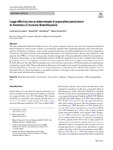Large Effective Size as Determinant of Population Persistence in Anostraca (Crustacea: Branchiopoda)

Use este enlace para citar
http://hdl.handle.net/2183/35242
A non ser que se indique outra cousa, a licenza do ítem descríbese como Atribución 4.0 Internacional
Coleccións
- Investigación (FCIE) [1227]
Metadatos
Mostrar o rexistro completo do ítemTítulo
Large Effective Size as Determinant of Population Persistence in Anostraca (Crustacea: Branchiopoda)Data
2023-05-26Cita bibliográfica
Sainz-Escudero, L., Vila, M., Perea, S. et al. Large effective size as determinant of population persistence in Anostraca (Crustacea: Branchiopoda). Conserv Genet 24, 675–692 (2023). https://doi.org/10.1007/s10592-023-01534-1
Resumo
[Abstract] The fairy shrimp Branchinectella media, because of its passive dispersal capacity and scarce and irregularly distributed habitats (temporary saline aquatic systems), is an intriguing organism from a population genomics and conservation perspective. Stochasticity of dispersal events and the irregular distribution of its habitat might lead to low levels of population connectivity and genetic diversity, and consequently, populations with limited persistence through time. Indeed, by using genomic data (SNPs), we found a strong genetic structure among some of the geographically isolated Iberian populations of B. media. Interestingly, we also obtained high estimates of effective population sizes. Lack of suitable habitat between populations (absence of a “stepping stone” network) and strong genetic differentiation suggest limited dispersal success in B. media. However, the high effective population sizes observed ensure persistence of B. media populations against genetic stochasticity (genetic drift). These results indicate that rescue-effect might not be essential for population persistence if they maintain high effective population sizes able to hold adequate levels of genetic diversity. Should high population sizes be reported in other low dispersing Anostraca, one might be optimistic with regard to their conservation status and fate, provided that their natural habitats remain undisturbed.
Palabras chave
Branchinectella media
Connectivity
Conservation
Dispersal
Population genomics
Effective population size
Connectivity
Conservation
Dispersal
Population genomics
Effective population size
Versión do editor
Dereitos
Atribución 4.0 Internacional
ISSN
1572-9737






